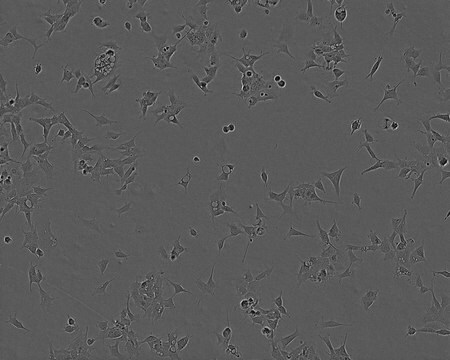MA104
85102918, African green monkey kidney, Epithelial
Sign Into View Organizational & Contract Pricing
All Photos(1)
About This Item
UNSPSC Code:
41106514
eCl@ss:
32190102
Recommended Products
product name
MA104, from African green monkey kidney, 85102918, Convention on the International Trade in Endangered Species of Wild Fauna and Flora (CITES)
biological source
African green monkey kidney
growth mode
Adherent
karyotype
Not specified
morphology
Epithelial
receptors
Not specified
Looking for similar products? Visit Product Comparison Guide
Cell Line Origin
Monkey African Green kidney
Cell Line Description
Established from an African green monkey foetal kidney. The cells are highly susceptible to Simian rotavirus SA11.
Please note: The species of origin of the MA104 cell line has been shown to be different from that claimed by the originators.
Whitaker & Hayward (1985) found the cell line to originate from an African green monkey and not a Rhesus macaque as was originally claimed. Whitaker AM and Hayward CJ (1985). The characterization of three monkey kidney cell lines. Develop. Biol. Standard. Vol 60: 125-131. PMID: 4043530. Abstract: Three monkey kidney cell lines, Vero, GL-V3 and MA-104 were subjected to karyological analysis to determine their chromosomal stability and to confirm their species of origin. Although the lines were shown to be relatively stable throughout all of the passage levels that were tested, the species of origin of one of them was found to be different from that claimed by the originators. This finding was supported by data from isoenzyme studies.
Please note: The species of origin of the MA104 cell line has been shown to be different from that claimed by the originators.
Whitaker & Hayward (1985) found the cell line to originate from an African green monkey and not a Rhesus macaque as was originally claimed. Whitaker AM and Hayward CJ (1985). The characterization of three monkey kidney cell lines. Develop. Biol. Standard. Vol 60: 125-131. PMID: 4043530. Abstract: Three monkey kidney cell lines, Vero, GL-V3 and MA-104 were subjected to karyological analysis to determine their chromosomal stability and to confirm their species of origin. Although the lines were shown to be relatively stable throughout all of the passage levels that were tested, the species of origin of one of them was found to be different from that claimed by the originators. This finding was supported by data from isoenzyme studies.
Culture Medium
Subculture Routine
Split sub-confluent cultures (70-80%) 1:3 to 1:10, i.e., seeding at 1-3x10,000 cells/cm2 using 0.25% trypsin or trypsin/EDTA; 5% CO2; 37 °C.
Other Notes
Additional freight & handling charges may be applicable for Asia-Pacific shipments. Please check with your local Customer Service representative for more information.
Certificates of Analysis (COA)
Search for Certificates of Analysis (COA) by entering the products Lot/Batch Number. Lot and Batch Numbers can be found on a product’s label following the words ‘Lot’ or ‘Batch’.
Already Own This Product?
Find documentation for the products that you have recently purchased in the Document Library.
Our team of scientists has experience in all areas of research including Life Science, Material Science, Chemical Synthesis, Chromatography, Analytical and many others.
Contact Technical Service




